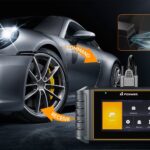Understanding how to set up your Konnwei OBD2 scanner is crucial for effectively diagnosing your vehicle’s health. These devices are designed to plug into your car’s OBD2 port, providing access to a wealth of data from your vehicle’s computer system, including engine diagnostics and more. This guide will walk you through the basic setup process to get you started.
Understanding KONNWEI OBD2 Scanners
OBD2 scanners, like those from KONNWEI, are invaluable tools for car owners and enthusiasts alike. They tap into the On-Board Diagnostics system present in most modern vehicles, allowing you to read error codes, monitor engine performance, and gain insights into your car’s operational status. Setting up your KONNWEI OBD2 scanner correctly ensures accurate data retrieval and efficient vehicle diagnostics.
Step-by-Step Konnwei OBD2 Setup Guide
Setting up your KONNWEI OBD2 device is generally straightforward. Here’s a step-by-step guide to get you connected and diagnosing your vehicle:
Physical Connection
- Locate the OBD2 Port: First, you need to find the OBD2 port in your vehicle. It’s typically located under the dashboard on the driver’s side. Check your vehicle’s manual if you’re unsure of the exact location.
- Plug in the KONNWEI OBD2 Scanner: With your car turned off, firmly plug your KONNWEI OBD2 scanner into the OBD2 port. Ensure it is securely connected.
Bluetooth Pairing (If Applicable)
- Turn on Ignition: Turn your car’s ignition to the “ON” position, but do not start the engine unless specified by your scanner’s instructions. This powers up the OBD2 port and your KONNWEI device.
- Enable Bluetooth on Your Device: On your smartphone, tablet, or laptop, enable Bluetooth.
- Pair with the OBD2 Scanner: Some KONNWEI OBD2 scanners require pairing via Bluetooth. Look for the scanner in your device’s Bluetooth settings. The scanner’s name might be something like “OBDII” or “KONNWEI-OBD2”. Select it to pair. You may be prompted for a pairing code, often “1234” or “0000”. Consult your KONNWEI device manual for the specific code if needed.
Software Setup
- Download a Compatible App: You’ll need an OBD2 application on your device to interpret the data from the KONNWEI scanner. Popular apps include Torque (Android), OBD Fusion (iOS and Android), and DashCommand (iOS and Android). Check your KONNWEI scanner’s manual or product description for recommended apps.
- Launch the App and Connect: Open the OBD2 app you’ve downloaded. Within the app settings, look for a connection or adapter setting. Select Bluetooth as the connection type and choose your KONNWEI OBD2 device from the list of available Bluetooth devices. The app should now connect to your scanner and begin receiving data from your vehicle.
Troubleshooting Common Konnwei OBD2 Setup Issues
Even with a straightforward setup, you might encounter some issues. Here are a few common problems and how to address them:
- Scanner Not Powering On: Ensure your car’s ignition is turned to the “ON” position. Check the OBD2 port for any damage or debris.
- Bluetooth Pairing Problems: Double-check the Bluetooth pairing code in your KONNWEI manual. Make sure Bluetooth is enabled on both your device and the scanner (if applicable). Try restarting both devices.
- App Connection Issues: Ensure the app you are using is compatible with your KONNWEI scanner and your device’s operating system. Check the app’s connection settings and ensure the correct Bluetooth device is selected.
Conclusion
Setting up your KONNWEI OBD2 scanner is generally a quick process. By following these steps, you should be able to connect your device, pair it with your smartphone or laptop, and start diagnosing your vehicle. If you continue to experience issues, consult your KONNWEI OBD2 scanner’s manual or seek support from the manufacturer or online forums for further assistance. With a properly set up KONNWEI OBD2 scanner, you’ll have valuable insights into your vehicle’s performance and health right at your fingertips.
